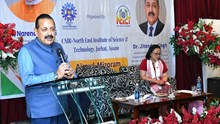
The 56th meeting of the Goods and Services Tax (GST) Council, chaired by Union Finance Minister Nirmala Sitharaman, has brought wide-ranging reforms to cut costs, ease compliance, and deliver much-needed relief to India’s farmers. The two-day meeting, which commenced in the capital on September 03, 2025, focused on rationalising GST rates across essential goods and services.
With targeted cuts in farm inputs, mechanisation equipment, food processing, and rural livelihoods, the Council’s decisions are being hailed as farmer-friendly, pro-rural, and pro-sustainability reforms that will strengthen India’s food security and competitiveness.
Union Minister for Finance and Corporate Affairs Smt. @nsitharaman chairs the 56th meeting of the GST Council, in New Delhi, today.
— Ministry of Finance (@FinMinIndia) September 3, 2025
The participants included Union Minister for State for Finance Shri @mppchaudhary, Chief Ministers of Delhi, Goa, Haryana, Jammu and Kashmir,… pic.twitter.com/pqz8upYg1U
Agriculture at the Core of GST Reforms
Agriculture and allied sectors received special attention in the rationalisation drive, with tax reliefs designed to directly benefit small and marginal farmers, cooperatives, and rural households.
Farm Mechanisation Gets Cheaper
-
Tractors (<1800 cc) to attract just 5% GST.
-
Tractor tyres, tubes, and hydraulic pumps reduced from 18% to 5%.
-
Sprinklers, drip irrigation, threshers, and diesel engines (≤15 HP) brought down from 12% to 5%.
Impact: Affordable machinery will accelerate mechanisation, reduce manual labour costs, and increase crop productivity. It also boosts access to shared equipment through cooperatives and Farmer Producer Organisations (FPOs).
Fertiliser Inputs Corrected
-
GST on ammonia, sulphuric acid, and nitric acid slashed from 18% to 5%.
Impact: By correcting the inverted duty structure, fertiliser prices will stabilise, ensuring timely and affordable supply for farmers during critical sowing seasons.
Bio-Pesticides & Micronutrients Encouraged
-
Twelve bio-pesticides and several micronutrients shifted from 12% to 5%.
Impact: A strong push for eco-friendly farming, soil health improvement, and support to natural farming initiatives, benefitting small organic growers and FPOs.
Food Processing & Perishables
-
Prepared and preserved fruits, vegetables, and nuts to attract 5% GST instead of 12%.
Impact: Encourages cold storage, reduces post-harvest losses, strengthens food processing industries, and boosts India’s export potential.
Dairy Sector Relief
-
No GST on milk and paneer.
-
Butter and ghee reduced to 5% from 12%.
-
Milk cans (iron, steel, aluminium) cut to 5% from 12%.
Impact: A direct boost to dairy farmers- especially women-led rural enterprises- while making essential protein and fat sources more affordable for households.
Aquaculture & Apiculture Support
-
Prepared or preserved fish reduced to 5% GST.
-
Natural honey brought down to 5%.
Impact: Strong support for pisciculture, beekeepers, tribal communities, and rural SHGs.
Sustainable Farming Push
-
Solar-powered irrigation devices reduced from 12% to 5%.
-
Kendu leaves, critical to tribal livelihoods in Odisha, Madhya Pradesh, and Chhattisgarh, slashed from 18% to 5%.
Impact: Encourages renewable energy adoption and secures income for tribal gatherers of minor forest produce.
Logistics and Supply Chain Efficiency
The Council also addressed logistics—a crucial link in the agri-economy.
-
GST on commercial trucks and delivery vans reduced from 28% to 18%.
-
Third-party insurance for goods carriers taxed at 5% with ITC benefits.
Impact: Cheaper freight will reduce transportation costs of agri-produce, making exports more competitive and lowering prices for consumers.
Industry Reactions to GST Reforms
Dr. Anish Shah, Group CEO & MD, Mahindra Group
“The next-generation GST reforms announced today mark a defining moment in India’s journey towards building a simpler, fairer, and more inclusive tax system. By moving to a streamlined two-rate structure and focusing on essentials that touch the lives of every citizen- from food, health, and insurance to agriculture and small businesses -the Government has reaffirmed its commitment to Ease of Living and Ease of Doing Business. The rationalisation measures will not only provide immediate relief to households but also strengthen key sectors such as automobiles, agriculture, healthcare, renewable energy, and MSMEs - all of which are vital to job creation and sustainable growth. The correction of long-pending inverted duty structures in critical industries is welcome.
At Mahindra, we view these reforms as transformative. They simplify compliance, expand affordability, and energise consumption, while enabling industry to invest with greater confidence. This bold step is in line with the vision articulated by the Hon’ble Prime Minister of building a citizen-centric, future-ready Bharat. It strengthens India’s economic foundations and will help drive the next phase of equitable and inclusive growth- journey towards Viksit Bharat @2047.”
Rajesh Jejurikar, ED & CEO -Auto and Farm Sector, M&M
“We applaud the Government for this landmark GST rationalisation, which will have a far-reaching positive impact across the automotive and farming sectors. The move makes tractors and farm machinery more affordable for farmers, reduces costs for commercial vehicles and improves accessibility for personal mobility through rationalisation of rates across all SUVs. Together, these measures are expected to stimulate demand, and drive inclusive growth across the entire ecosystem.
We also appreciate the continuation of the 5% GST rate on EVs, which is a critical enabler of India’s clean mobility vision. This measure will further accelerate the adoption of electric vehicles and reinforce India’s leadership in sustainable, green transportation.”
Narinder Mittal, President & Managing Director, CNH India
“We welcome the government’s decision to reduce GST on farm equipment, related components and tyres to 5%. These GST reforms will accelerate mechanization by making tractors, harvesters, balers and implements more affordable, while lowering overall operating costs for farmers. This empowers industry players to address labour shortages, enhance farmer’s productivity, and promote sustainable practices. For CNH, it provides the right environment to further localize, innovate, and expand our offerings, strengthening India’s role as a global CNH hub for farm machinery. As a leader in the harvesting and post harvesting segment, we see this reform as particularly timely ahead of the harvesting season, as lower costs will enable more farmers to adopt baling solutions, reducing crop residue burning and its impact on the environment.”
Divya Kumar Gulati, Chairman at CLFMA of India
"CLFMA of India welcomes the GST Council’s decision to rationalize tax rates on dairy products as well as key agricultural inputs. The reduction — with UHT milk becoming tax-free, and other dairy products including condensed milk, butter, ghee, paneer, and cheese moving from 12% to 5% — is a progressive step that will make nutritious dairy more affordable for consumers. Equally encouraging are the GST cuts on agricultural products and machinery, all reduced to 5%, which will ease costs for farmers and promote mechanization. Together, these reforms will not only benefit India’s 80 million dairy farmers, but also boost rural incomes, encourage greater investment in feed and animal care, and contribute significantly to both nutrition security and agricultural growth."
Ravindra Agrawal, Founder and Chairman of KisanKraft Limited
“The recent GST reforms are a pivotal moment for Indian agriculture, especially farm mechanization. Reducing GST from 12% to 5% on equipment like drip irrigation, composting machines, and harvesters will cut costs for small farmers and accelerate adoption of sustainable agri-tech. This is more than financial relief — it’s a strong push towards productivity, climate-smart farming, and positioning India as a global leader in sustainable agriculture."
Agnishwar Jayaprakash, Founder and CEO, Garuda Aerospace
"We welcome this landmark move and believe that the reduction of GST to 5% will empower drone-tech companies in multiple ways. For companies like Garuda Aerospace, which strongly believe that indigenous drones are the need of the hour, this reform provides the opportunity to deepen investments in R&D, foster innovation, and scale up manufacturing. Lower costs also enable us to explore entry into new markets, encouraging and promoting the wider use of drones. This move directly improves the affordability of drones for farmers and allied sectors, further boosting the adoption of agri-drones across the country. It is also a step forward for initiatives like NaMo Drone Didi, which promote precision agriculture through drone usage. Moreover, it equips defence and surveillance sectors with cost-effective drone solutions for public safety, disaster management, and other critical applications. We anticipate that this progressive step towards making India the global hub for drone technology and being Atmanirbhar Bharat will enhance productivity and efficiency, while accelerating drone adoption across industries such as logistics and infrastructure."
Saroj Kumar Mahapatra, Executive Director, PRADAN
"The recent GST reforms, especially the rationalisation of tax slabs and reduction in rates on essential goods and services, are a significant and progressive step towards building a more inclusive and growth-driven economy. For the agriculture sector, which remains the backbone of rural India, these changes could bring much-needed relief and momentum.
The reduction in GST on critical agri-inputs such as fertilizers, agrochemicals, farm machinery, and food processing equipment will help lower operational costs for farmers and agri-entrepreneurs. This directly translates to better profit margins for small and marginal farmers who are often burdened by high input costs. They will be able to invest more in farm mechanization. Moreover, by easing the compliance process, the reforms will empower farmer producer organisations (FPOs) and rural agri-startups to scale operations, access markets more efficiently, and formalise their businesses."
Rajesh Aggarwal, Managing Director, Insecticides India Ltd.
"The GST Council’s decision to reduce GST to 5% on essential mechanization tools including tractors, tyres, drip irrigation systems, sprinklers, and agricultural machinery is a welcome and progressive reform for Indian agriculture.
Equally encouraging is the reduction of GST on nutrients and bio-based products. This makes advanced crop nutrition and sustainable biological solutions more affordable and accessible, especially for small and marginal farmers. Together, these measures significantly ease the cost burden on the farming community.
By lowering the cost of mechanization, nutrients, and bio-products, farmers are better positioned to invest in crop protection solutions that drive higher productivity and safeguard yields. This holistic reform not only empowers farmers but also strengthens the entire agricultural value chain, accelerating India’s journey toward resilient, efficient, and sustainable farming."
Ayush Gupta, Head – India Business, KRBL
“KRBL notes the GST Council’s decision to keep the tax rate on essential food items, including rice and edible oils, unchanged. This continuity provides stability, ensuring that staple foods remain affordable for households nationwide, while supporting both consumers and the broader economy.
At the same time, the reduction of GST on value-added food categories to 5% is a progressive step that will encourage innovation in food, open opportunities for new product development, and strengthen India’s FMCG landscape. The overall rationalisation of rates will not only boost consumption but also play an important role in managing inflation. While staples remain unchanged, the tailwinds provided across other categories of consumption will enhance household spending and stimulate economic activity.
For KRBL, with deep roots in farming communities and a growing presence in FMCG, this clarity and stability provide a strong foundation for innovation, investment, and sustainable export-led growth. As a leader in the rice industry, we remain committed to food security, accessibility, and contributing to India’s economic growth while supporting both farmers and consumers.”
Agriculture goods such as tractors, agricultural, horticultural and forestry machines for soil preparation or cultivation, harvesting or threshing machines, including straw or fodder balers, grass or hay movers, composting machines etc. all will be taxed at a #GST rate of 5%,… pic.twitter.com/vz6AdrHwx8
— PIB India (@PIB_India) September 3, 2025
Towards Atmanirbhar Bharat
Collectively, these reforms sharpen India’s edge in domestic food production and strengthen the agri-value chain against imports. By reducing input costs, making mechanisation more accessible, and encouraging value-added processing, the GST Council has laid the foundation for a more self-reliant rural economy. For farmers, cooperatives, and agri-enterprises alike, the 56th meeting will be remembered as a turning point that linked tax policy with prosperity, sustainability, and national food security, taking the country closer to its broader vision of inclusive development and Viksit Bharat@2047.
















